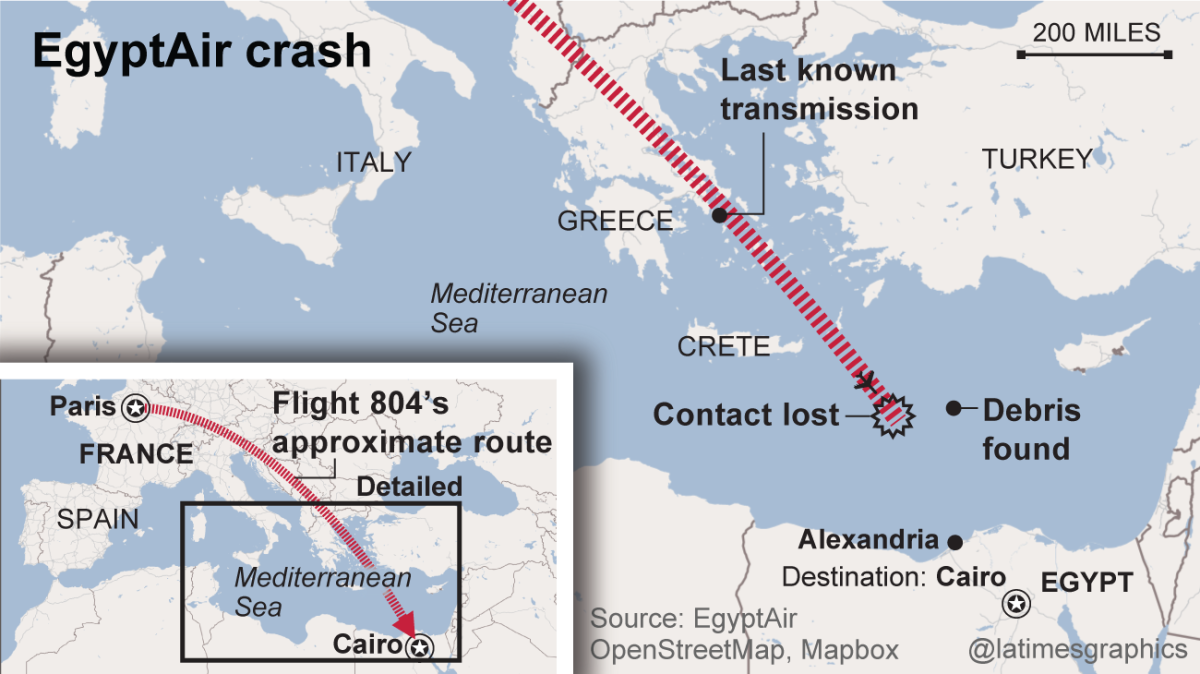What we know about the crash of EgyptAir Flight 804

The Egyptian military has located wreckage from EgyptAir Flight 804 about 180 miles north of the coastal city of Alexandria, Egypt. The Airbus A320 aircraft vanished from radar screens early May 19 while carrying 66 people from Paris to Cairo.
Here is what we know so far:
What has been found from the plane?

EgyptAir said the debris recovered includes passengers’ belongings, suitcases and aircraft seats. Body parts also have been found, the airline said.
On June 16, the cockpit voice recorder of the plane was recovered and pulled out of the Mediterranean Sea. The next day, the second black box was found.
See more of our top stories on Facebook »
The find significantly raises hopes that investigators will finally be able to determine what caused the crash. Both France and the United States are sending investigators to Cairo to help with the probe.
A statement from the Egyptian committee said the vessel John Lethbridge, contracted by the Egyptian government to search for the plane wreckage, pulled the data recorder out of the sea in stages. It added that it managed to “successfully retrieve” the memory unit of the recorder, which is the “most important” component.
The committee said that the data will be downloaded and analyzed once it arrives from the port city of Alexandria, where the black boxes will be transferred from the site of the crash.
What do we know about the plane’s final moments?

11:09 p.m. May 18: Flight 804 takes off from Paris’ Charles de Gaulle Airport on route for Cairo, where it was scheduled to arrive at 3:15 a.m. the following day.
1:24 a.m. May 19: The plane enters Greek airspace.
2:26 a.m.: The pilot speaks with air traffic controllers in Greece. No problems are reported.
2:37 a.m.: The plane enters Egyptian airspace. Shortly after, it makes a 90-degree turn to the left, then a 360-degree loop to the right, plunging from 37,000 to 15,000 feet before disappearing from radar at about 10,000 feet, according to the Greek defense minister, Panos Kammenos.
What might have caused the crash?

The cause is not yet known. But the Egyptian minister for civil aviation, Sherif Fathi, said an act of terrorism was more likely than a mechanical failure.
Egypt and France have both been the target of attacks by Islamist extremists. In October, the Islamic State group claimed responsibility for bringing down a Russian passenger plane over Egypt’s Sinai Peninsula, killing 224 people on board.
NEWSLETTER: Get the day's top headlines from Times Editor Davan Maharaj >>
Aviation safety experts said the Airbus plane’s swerves and sudden drop are not typical of a technical malfunction and suggest that a “catastrophic” event took place on board.
They said there was a strong possibility of an explosion. A hijacker also could have tried to commandeer the aircraft, resulting in a struggle in the cockpit. Or the pilot might have intentionally crashed the plane.
Whatever happened, it appears to have been sudden: There was no distress call.
What do we know about the plane and pilots?

Airbus 320s are considered reliable aircraft and are among the most common planes used in air travel. The aircraft in question went into service in 2003, which is not that old for a jet.
The plane was on its fifth flight that day. It flew from Asmara, Eritrea, to Cairo, then to the Tunisian capital, Tunis, and back to Cairo, before flying to Paris.
EgyptAir said experienced pilots were at the controls on the flight from Paris to Cairo. The captain had more than 6,000 flying hours, including 2,100 on the A320. The copilot had 2,766 flying hours.
Who was on board?
EgyptAir said the plane was carrying 56 passengers, seven crew members and three airline security personnel.
Of the passengers aboard, 30 were Egyptians, 15 were from France and two were from Iraq. There also were passengers from Canada, Belgium, Britain, Saudi Arabia, Sudan, Chad, Portugal, Algeria and Kuwait. They included two babies and a child.
No Americans were on the passenger list.
Twitter: @alexzavis
Times staff writers Shashank Bengali in Cairo and Del Quentin Wilber in New York contributed to this report along with special correspondents Amro Hassan in Cairo and Kim Willsher in Paris.
ALSO
Terrorists may have brought down EgyptAir flight, officials say
What we know so far about the people who were on board EgyptAir Flight 804
Human remains and wreckage from EgyptAir Flight 804 found in Mediterranean
UPDATES:
7:20 a.m., June 17: This article has been updated with news that the plane’s two black boxes have been recovered.
This article was originally published on May 20.
Start your day right
Sign up for Essential California for news, features and recommendations from the L.A. Times and beyond in your inbox six days a week.
You may occasionally receive promotional content from the Los Angeles Times.



